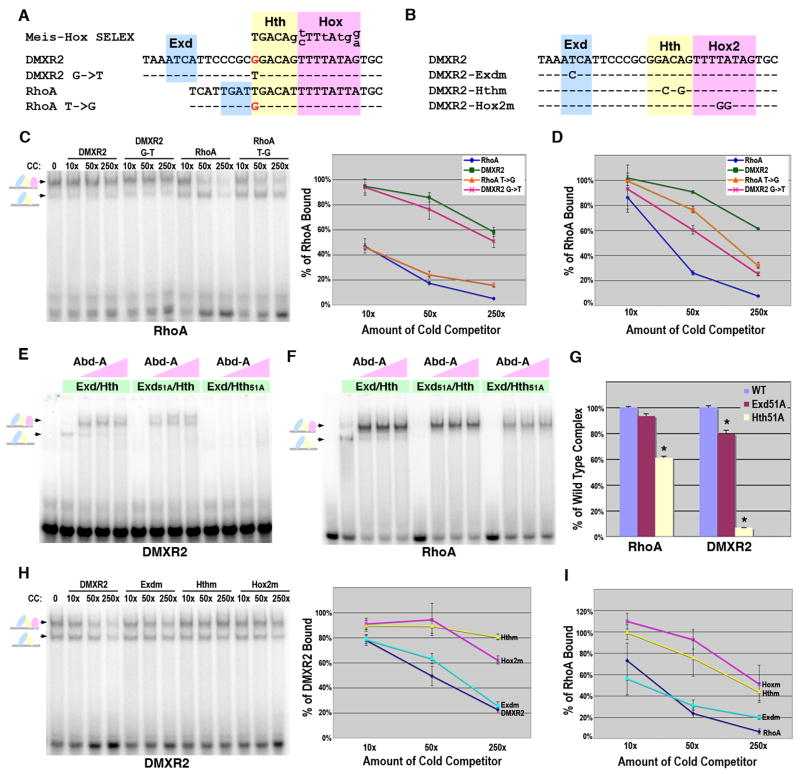Figure 3. Dependence of Hox complex formation on the Exd, Hth, and Hox sites in DMXR2 and RhoA.
A. Sequence comparison of the DMXR2, RhoA, and Meis-Hox site previously identified using site selection assays (SELEX) (Shen et al., 1997). Lower case letters in the Meis-Hox SELEX denote nucleotides under less constraint. The Hth (yellow) and Hox (pink) sites are highlighted and mismatches from SELEX consensus are in red text. The Exd binding sites are highlighted in blue. B. The DMXR2 Exd, Hth, and Hox2 point mutations used in gel shift analysis. C. DNA binding competition assays for Abd-A, Exd and Hth complexes on RhoA, RhoA-T>G, DMXR2, and DMXR2-G>T. Labeled RhoA probe was bound with a constant amount (75 × 10-9 M) of Exd/Hth and Abd-A. Different amounts of competitor were added as indicated. Schematics at left denote color-coded complexes (Exd, blue; Hth, yellow; Abd-A, pink). The amount of probe bound in absence of competitor was assigned 100% binding and the graph (at right) depicts the average amount of probe bound in presence of competitor from three different experiments with standard error noted. D. Graph of DNA binding competition assays of Exd/Hth (75 × 10-9 M) binding on RhoA, RhoA-T>G, DMXR2, and DMXR2-G>T in the absence of Hox factors. Three experiments were performed and the average amount of probe bound in absence and presence of competitor was compared with standard error noted. E. Comparative EMSAs using wild type and mutant Exd/Hth heterodimers with Abd-A on DMXR2. Equimolar amounts of Exd/Hth, Exd51A/Hth, and Exd/Hth51A proteins (30 × 10-9 M) were used with three concentrations of Abd-A (7.5 × 10-9 M, 22.5 × 10-9 M, and 70 × 10-9 M). F. Comparative EMSAs using wild type and mutant Exd/Hth heterodimers with Abd-A on RhoA. Equimolar amounts of Exd/Hth, Exd51A/Hth, and Exd/Hth51A proteins (15 × 10-9 M) were used with three concentrations of Abd-A (7.5 × 10-9 M, 22.5 × 10-9 M, and 70 × 10-9 M). G. Assessing the dependence of Hox complex formation on Exd and Hth binding to DMXR2 and RhoA. Comparative DNA binding assays were performed in triplicate using equimolar amounts of Exd/Hth, Exd51A/Hth, and Exd/Hth51A proteins and Abd-A. The average amount of probe bound by Abd-A and the wild type Exd/Hth proteins was assigned to 100% for each probe tested (blue bar). The amount of probe bound by Exd51A/Hth (red bar) and Exd/Hth51A (yellow bar) compared to wild type was determined. Standard error bars are noted and * denotes significant difference from wild type binding (p-value < 0.001). H. DNA binding competition assays for Abd-A, Exd and Hth complexes on wild type, Exdm, Hthm, and Hox2m DMXR2 probes. Labeled DMXR2 probe was bound with a constant amount (75 × 10-9 M) of Exd/Hth and Abd-A. Different amounts of competitor were added as indicated. Schematics at left denote color-coded complexes (Exd, blue; Hth, yellow; Abd-A, pink). The amount of probe bound in absence of competitor was assigned 100% binding and the graph (at right) depicts the average amount of probe bound in presence of competitor in three different experiments. I. DNA binding competition assays for Abd-A, Exd and Hth complexes using wild type, Exdm, Hthm, and Hoxm RhoA probes. Labeled RhoA probe was bound with a constant amount (75 × 10-9 M) of Exd/Hth and Abd-A. The amount of probe bound in absence of competitor was assigned 100% binding and the graph depicts the average amount of probe bound in the presence of competitor in three different experiments.

